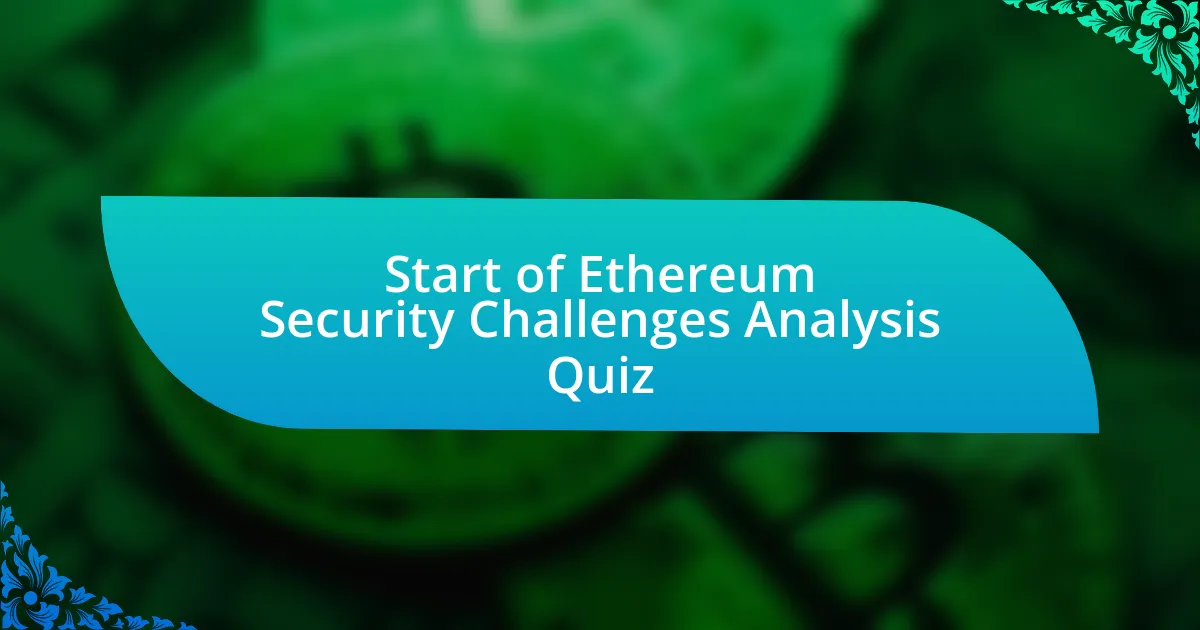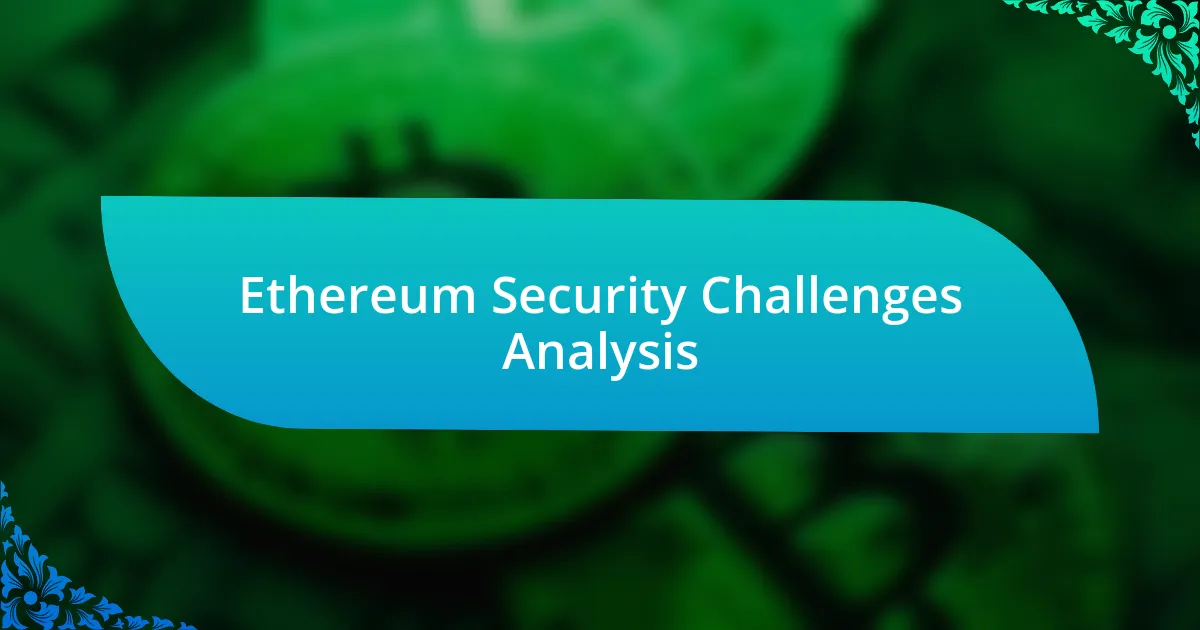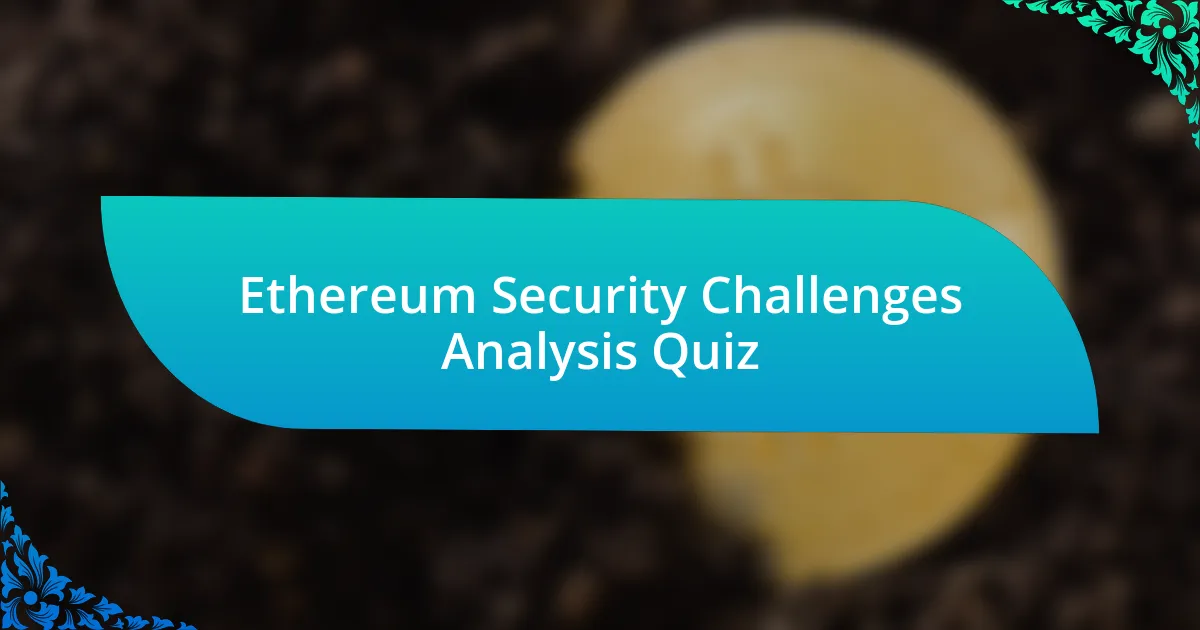
Start of Ethereum Security Challenges Analysis Quiz
1. What is the primary security issue faced by smart contracts?
- Smart contract security vulnerability.
- Limited programming languages available.
- Inconsistent user interface design.
- Network congestion issues.
2. How many blockchain security incidents occurred across the network as of the end of June 2022?
- 245
- 102
- 187
- 312
3. What was the total loss suffered due to these blockchain security incidents?
- $500 million
- $1.976 billion
- $850 million
- $3.5 billion
4. How many Ethereum contracts are currently in existence?
- 19,366
- 25,432
- 12,789
- 30,001
5. What percentage of Ethereum contracts are considered insecure?
- 12.1%
- 70.5%
- 45.8%
- 25.0%
6. What vulnerability led to the DAO hack?
- SQL injection flaw.
- Denial of service attack.
- Buffer overflow issue.
- Reentrancy vulnerability.
7. What was the impact of the DAO hack on the Ethereum community?
- It increased transaction fees for all users.
- It resulted in a market crash of Bitcoin.
- It led to a split in the Ethereum community.
- It caused a temporary outage of the network.
8. How much was lost due to the Parity multi-signature wallet security issue?
- $75 million.
- $300 million.
- $182 million.
- $50 million.
9. What is reentrancy in the context of Ethereum smart contracts?
- Reentrancy occurs when a contract fails to validate input data properly.
- Reentrancy is when a contract self-destructs and removes itself from the blockchain.
- Reentrancy is when a smart contract can be executed multiple times simultaneously by the same user.
- Reentrancy occurs when a contract makes an external call to another contract, allowing the called contract to use the intermediate state of the calling contract.
10. What are some common types of reentrancy attacks?
- Direct-call, indirect-call, loop-based, and cross-thread reentrancy attacks.
- Acyclic, cyclic, transaction-oriented, and gas-limited reentrancy attacks.
- Single-function, cross-function, cross-contract, and read-only reentrancy attacks.
- Time-based, event-triggered, single-state, and blind reentrancy attacks.
11. What is the Yearn Finance hack an example of?
- An example of a hack due to incorrect deploy and post-deploy settings.
- An example of a social engineering exploit.
- An example of a phishing attack targeting users.
- An example of an exchange security breach.
12. How much was lost in the Yearn Finance hack?
- $11 million
- $5 million
- $50 million
- $20 million
13. What is the ERC4626 standard?
- The ERC4626 standard outlines governance rules for decentralized organizations.
- The ERC4626 standard is a tokenized vault standard introduced to create a structured representation for tokenized debt.
- The ERC4626 standard is a protocol for creating non-fungible tokens (NFTs).
- The ERC4626 standard defines a method for cross-chain communication.
14. What are the potential vulnerabilities in ERC4626 vaults?
- All ERC4626 vaults are automatically audited for security.
- Potential flaws in the logic or setup of ERC4626 vaults can be exploited in inflation attacks.
- The assets in ERC4626 vaults cannot be manipulated by users.
- ERC4626 vaults are immune to external economic conditions.
15. Who are the original authors of Ethereum?
- Brian Armstrong and Vitalik Buterin
- Satoshi Nakamoto and Hal Finney
- Vitalik Buterin and Gavin Wood
- Charlie Lee and Roger Ver
16. What is the Ethereum Virtual Machine (EVM)?
- A centralized registry for Ethereum accounts.
- A type of bitcoin wallet with enhanced features.
- A decentralized virtual machine capable of handling scripts using the public nodes network.
- A protocol for traditional banking systems.
17. What is the value token for Ethereum?
- Bitcoin (BTC)
- Litecoin (LTC)
- Ripple (XRP)
- Ether (ETH)
18. How do you mine Ethers?
- You can mine Ethers by trading them in exchanges only.
- You simply download software to start mining without any hardware.
- You need to have a wallet and tools like Geth CLI, participate in the network, and help add transactions to the blocks.
- You must stake other cryptocurrencies for mining Ethers.
19. What is MetaMask?
- A popular browser-based Ethereum wallet used to interact with dApps on the Ethereum network.
- An online marketplace for buying and selling digital art.
- A programming language designed for blockchain development.
- A decentralized social media platform for sharing content.
20. What programming languages can be used to write smart contracts and dApps?
- HTML
- Solidity
- Python
- Java
21. What is Truffle?
- A testing and development environment for Ethereum
- A luxury perfume brand
- A type of gourmet chocolate
- A high-end restaurant chain
22. What is the block time in Ethereum?
- 10 seconds
- 14 seconds
- 30 seconds
- 20 seconds
23. Can transactions be kept hidden in the public Ethereum network?
- Only certain transactions are visible to the public.
- Yes, transactions can be completely hidden.
- Transactions are hidden unless shared by the user.
- No, all transactions are public.
24. Is the user’s private key used to sign transactions?
- Only for verification.
- Only in public transactions.
- No.
- Yes.
25. How do you recover an Ethereum account with no private key?
- Using the 12-word mnemonic set during account creation.
- Purchasing a new private key from a vendor.
- Resetting the account password via email.
- Contacting Ethereum support for account recovery.
26. What is Geth?
- A type of Ethereum token standard.
- A decentralized storage solution.
- A popular Ethereum wallet application.
- A command-line interface used to run a full Ethereum node.
27. How can you connect to a node in Ethereum?
- Using FTP, HTTP, or SMTP.
- Using SSH, Telnet, or FTP.
- Using SMTP, POP3, or IMAP.
- Using WS-RPC, JSON-RPC, or IPC-RPC.
28. What is Geth’s fast sync?
- It optimizes the mining process for faster blocks.
- It updates the user interface in real-time.
- It works by syncing the download transaction.
- It establishes a secure connection to external wallets.
29. How does Bitcoin differ from Ethereum in checking the latest state?
- Bitcoin verifies transactions through smart contracts, while Ethereum relies solely on user input.
- Bitcoin checks unspent transaction outputs (UTXO), while Ethereum checks the latest account balance.
- Bitcoin and Ethereum both check the blockchain hash to determine the latest state.
- Bitcoin uses blocks to track transaction confirmations, while Ethereum relies on mining rewards.
30. What happens when the gas runs out without the transaction being complete?
- The transaction will be completed without using gas.
- All state changes are reversed, and the used Ethereum Gas is given to the miner.
- The gas cost is refunded to the user.
- The transaction will automatically retry after a delay.

Quiz Successfully Completed!
Congratulations on finishing the quiz on Ethereum Security Challenges Analysis! You’ve engaged with a crucial topic that impacts not just developers, but anyone interested in the future of digital currencies. Through this quiz, you’ve likely gained insights into key security vulnerabilities faced by Ethereum. Understanding these challenges is essential in navigating the evolving landscape of blockchain technology.
As you reflected on common issues like smart contract vulnerabilities, network attacks, and the measures to mitigate these risks, you’ve taken a step forward in deepening your knowledge. Each question provided an opportunity to explore different facets of Ethereum’s security challenges. You now have a stronger foundation to understand how these factors affect the broader ecosystem.
We invite you to continue your journey of discovery. Our next section on this page includes detailed information about Ethereum Security Challenges Analysis. Dive deeper into case studies, best practices, and potential solutions that can further enhance your comprehension of this dynamic field. Your learning doesn’t stop here, so let’s explore together!

Ethereum Security Challenges Analysis
Overview of Ethereum’s Security Architecture
Ethereum’s security architecture is designed to protect the blockchain from various threats. It incorporates a consensus mechanism, which is currently proof of stake (PoS), to validate transactions. This system secures the network against double-spending and Sybil attacks. Smart contracts also undergo audits to prevent vulnerabilities. Ethereum employs cryptographic techniques for data integrity and user anonymity. Such measures form a foundational layer aimed at fostering a secure environment for decentralized applications (dApps) and users.
Common Security Vulnerabilities in Smart Contracts
Smart contracts are prone to specific vulnerabilities, including reentrancy, overflow/underflow, and improper access control. These flaws can lead to significant financial losses and breaches in privacy. For instance, the infamous DAO hack in 2016 exploited a reentrancy vulnerability to siphon funds. Auditors highlight the importance of rigorous testing and formal verification to mitigate these risks. Identifying and addressing these vulnerabilities is crucial for maintaining user trust and network security.
Impact of Consensus Mechanism on Security
The shift from proof of work (PoW) to proof of stake (PoS) significantly alters Ethereum’s security dynamics. PoS reduces energy consumption and lowers the risk of centralized mining pools. However, it introduces new attack vectors such as long-range attacks and stake centralization. Validators must act honestly to maintain their position and receive rewards, incentivizing legitimate behavior. Understanding these implications is vital for assessing the overall security of the Ethereum network.
Challenges with Decentralized Finance (DeFi) Security
DeFi applications pose unique security challenges due to their complexity and reliance on smart contracts. Flash loan attacks exploit the instantaneous nature of borrowing without collateral, showcasing vulnerabilities in protocol design. Additionally, inadequate governance models can result in the mismanagement of resources. The non-custodial nature of DeFi further complicates recovery options for users after potential losses. Addressing these challenges is essential for fostering user confidence in DeFi solutions.
Future Directions for Enhancing Ethereum Security
Enhancing Ethereum’s security involves ongoing research and community collaboration. Implementing stronger auditing tools and formal verification methods can reduce smart contract vulnerabilities. Developing better governance frameworks for decentralized applications ensures robust risk management. Furthermore, innovations such as Ethereum 2.0 aim to improve security while enhancing scalability. Continuous improvements and active community engagement are paramount for advancing Ethereum’s resilience against emerging threats.
What are the main security challenges faced by Ethereum?
The main security challenges faced by Ethereum include smart contract vulnerabilities, decentralized application (dApp) attacks, network congestion, and consensus layer weaknesses. Smart contracts can contain bugs that lead to significant financial losses; for example, the DAO hack in 2016 resulted in a loss of $50 million. Additionally, dApps can be targets for phishing and other attacks. Network congestion can lead to increased gas fees and delayed transactions, limiting usability. Finally, the transition to proof-of-stake has raised concerns about potential centralization and validator collusion.
How does Ethereum protect against security vulnerabilities?
Ethereum employs several mechanisms to protect against security vulnerabilities, including rigorous peer review processes, the use of formal verification for smart contracts, and bug bounty programs. Formal verification allows developers to mathematically prove the correctness of smart contracts before deployment. The Ethereum Foundation also incentivizes security research through external bug bounty programs, which reward individuals who identify vulnerabilities within the ecosystem. These measures aim to mitigate risks effectively.
Where do most security breaches in Ethereum occur?
Most security breaches in Ethereum occur within smart contracts and decentralized finance (DeFi) applications. These breaches often arise from coding flaws, poorly devised mechanisms, or inadequate auditing practices. A significant example is the 2018 incident involving the Parity wallet, which led to the freezing of over $300 million in Ether due to a programming error in a multi-signature contract. Such instances illustrate that many vulnerabilities originate in smart contract implementation.
When did Ethereum face its most significant security incident?
Ethereum faced its most significant security incident during the DAO hack in June 2016. Hackers exploited a vulnerability in the DAO smart contract, draining approximately 3.6 million Ether, worth around $50 million at the time. This incident raised awareness about smart contract security and prompted discussions on whether to implement a hard fork to return the stolen funds to investors, ultimately leading to the Ethereum Classic split.
Who is responsible for addressing Ethereum’s security challenges?
The responsibility for addressing Ethereum’s security challenges is shared among multiple stakeholders, including developers, auditing firms, the Ethereum Foundation, and the broader community. Developers must ensure their code is secure, while auditing firms conduct independent assessments of smart contracts. The Ethereum Foundation supports research and promotes best practices for security. Additionally, the community plays a role in reporting vulnerabilities and contributing to discussions about improving security. This collective effort is essential for bolstering the security of the Ethereum ecosystem.

